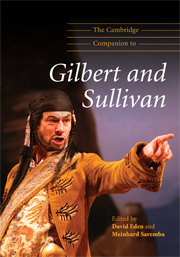Book contents
- Frontmatter
- Part I Background
- Part II Focus
- 5 The operas in context: stylistic elements – the Savoy and beyond
- 6 The librettos in context: Gilbert's ‘fables in song’
- 7 ‘This particularly rapid, unintelligible patter’: patter songs and the word–music relationship
- 8 Standing still and moving forward: The Mikado, Haddon Hall and concepts of time in the Savoy operas
- 9 Musical contexts I: motives and methods in Sullivan's allusions
- 10 Musical contexts II: characterisation and emotion in the Savoy operas
- Part III Reception
- Part IV Into the twenty-first century
- Appendix 1 Who wrote the overtures?
- Appendix 2 Stage and choral works by Arthur Sullivan and W. S. Gilbert
- Appendix 3 Modern editions of works by Arthur Sullivan and W. S. Gilbert
- Appendix 4 Sullivan's archetypes of English opera
- Notes
- Bibliography and further reading
- Index
- Plate section
7 - ‘This particularly rapid, unintelligible patter’: patter songs and the word–music relationship
from Part II - Focus
Published online by Cambridge University Press: 28 September 2011
- Frontmatter
- Part I Background
- Part II Focus
- 5 The operas in context: stylistic elements – the Savoy and beyond
- 6 The librettos in context: Gilbert's ‘fables in song’
- 7 ‘This particularly rapid, unintelligible patter’: patter songs and the word–music relationship
- 8 Standing still and moving forward: The Mikado, Haddon Hall and concepts of time in the Savoy operas
- 9 Musical contexts I: motives and methods in Sullivan's allusions
- 10 Musical contexts II: characterisation and emotion in the Savoy operas
- Part III Reception
- Part IV Into the twenty-first century
- Appendix 1 Who wrote the overtures?
- Appendix 2 Stage and choral works by Arthur Sullivan and W. S. Gilbert
- Appendix 3 Modern editions of works by Arthur Sullivan and W. S. Gilbert
- Appendix 4 Sullivan's archetypes of English opera
- Notes
- Bibliography and further reading
- Index
- Plate section
Summary
The analysis of comedy in Gilbert and Sullivan comic operas regularly centres on Gilbert's librettos, as if they were the sole source of humour. Indeed, Sullivan seems to have shared this view, although Gilbert did not. Gilbert once said of Sullivan, ‘He used to maintain, oddly enough, that there was no such thing as humour in music, but in my humble judgment he was, himself, a musical humorist of the very highest order’. To be sure, words and music each have humour, but there is a third kind of humour at work in Gilbert and Sullivan, as is most vividly shown in their patter songs. This humour stems from the formal relationship between words and music. In patter songs, consonants and vowels tumble over each other in sheer sonic joy, careering at the absolute edge of intelligibility. The question of intelligibility that these songs raise forces a re-evaluation of the boundaries between words and music. It then seems necessary to ask how this effect is produced and why the patter song's status on the border of intelligibility is funny.
Despite the frequent use of the term ‘patter song’ in Gilbert and Sullivan criticism and reviews, the form is not clearly defined. Its properties are usually left to be inferred from examples like ‘I am the very model of a modern Major-General’. Even the gold standard of music dictionaries, The New Grove Dictionary of Music, does not give a richly formal definition: ‘A comic song in which the humour derives from having the greatest number of words uttered in the shortest possible time’. A patter song is not defined by its structure at the level of bars or sections (like a blues or a symphony), but by a much smaller unit of measure: the relationship between words and time.
Information
- Type
- Chapter
- Information
- The Cambridge Companion to Gilbert and Sullivan , pp. 98 - 108Publisher: Cambridge University PressPrint publication year: 2009
Accessibility standard: Unknown
- 1
- Cited by
